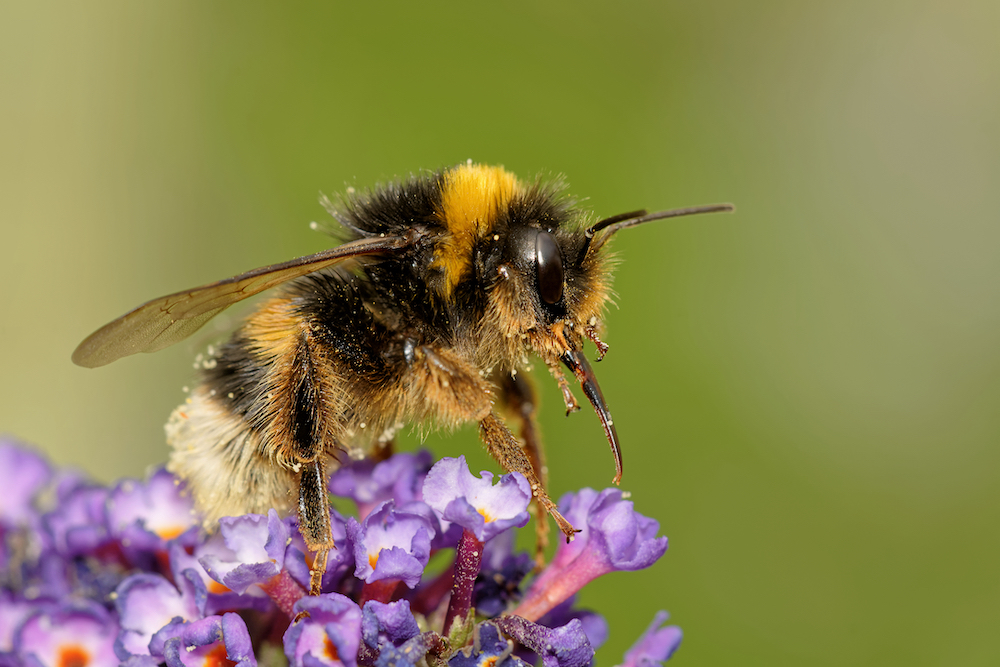4 More Facts About Bumble Bees

Many people find that they know a lot about honey bees, but not enough about bumble bees. Recently, we shared an article on our Bee Blog that answered 5 of the most frequent questions we get about bumble bees. Today, we will share 4 more fascinating facts about these insects so you learn even more about their behavior and role in our ecosystem.
Honey bees and bumble bees share some of the same characteristics. After all, they are both in the Apidae family. However, there are some very interesting differences that make bumble bees completely unique.
What is the life cycle of a bumble bee?
The life cycle of the bumble bee is a bit different from that of the honey bee. The process really begins in the early fall when a new queen will leave the nest in search of a few suitable mates and a place to hibernate for the winter. Once impregnated, she will enter her hibernation den and wait until early spring to emerge.
When ready, she will leave her winter home and immediately begin collecting pollen and nectar for the much-needed energy that they provide. Her next order of business is to find a location for her nest. When she finds the perfect spot, she will begin building the colony by laying eggs and incubating them for approximately two weeks.
Now, the bees are developed and ready to emerge from their cocoons. The worker bumble bees will appear first, followed by the males and young queen bees. The males will go about their role of mating, whereas the young queens will lay low. Before winter hits, the new queens will leave the nest to mate and hibernate, beginning the cycle all over again.
How do bumble bees aid in pollination?
There are certain unique features of a bumble bee that make her a wonderful pollinator. For one, they have furry bodies that act like magnets for pollen. This pollen is then carried to other plants during a bumble bee’s foraging trips.
Secondly, bumble bees are typically foraging longer than most other bee species. New queens can emerge as early as February, meaning that her eggs will hatch and begin pollinating in the late winter or early spring. Bumble bees are also known to pollinate well into November!
Finally, bumble bees can do something called “buzz pollination,” making them even more efficient at pollinating certain types of crops such as tomatoes, blueberries and strawberries. Bumble bees will vibrate their upper bodies near the anthers of a plant to release their pollen.
How do bumble bees communicate?
Honey bees are known for using a waggle dance to communicate the locations of good foraging spots, water and their new hive. Researchers do not believe that bumble bees communicate in this same way. There is evidence that bumble bees communicate using odors; specifically, they release a pheromone that tells other bees to begin foraging.
Can I remove a bumble bee nest?
While bumble bee nests can be relocated, it is very rarely required. Bumble bee nests are usually small, averaging about 200 bees. They are generally built in shaded, out-of-the-way areas or underground. Nests are not usually a danger to human beings, especially since they are very docile creatures to begin with! Also, because bumble bee hives are small and do not contain honey, they do not pose much threat to any structure they are built upon.
Another consideration is that the entire colony will die at the end of the season. Only the new queens will survive. If the nest is compromised or destroyed before the new queens have had the chance to leave and mate, the entire generation will be destroyed and no bumble bees from that colony will ever be produced.
You’ve already learned a lot about bumble bees! But, there is always more to know. We encourage you to do your research to learn more about how bumble bees contribute to our agricultural system, and the environment as a whole. The more we know about the environment and all of the creatures that contribute to it, the more we can do to protect it.
Do you have questions about honey bees or bumble bees on your San Diego property? Contact D-Tek Live Bee Removal today.
